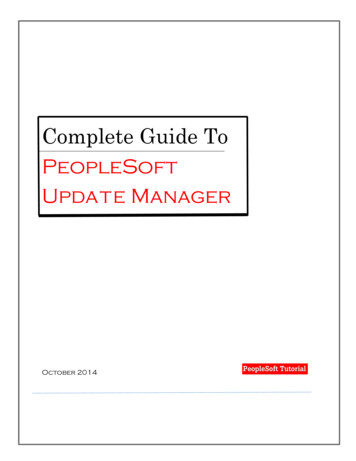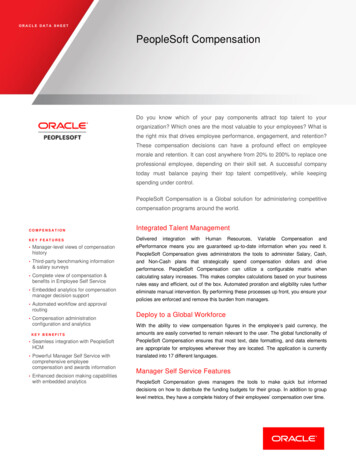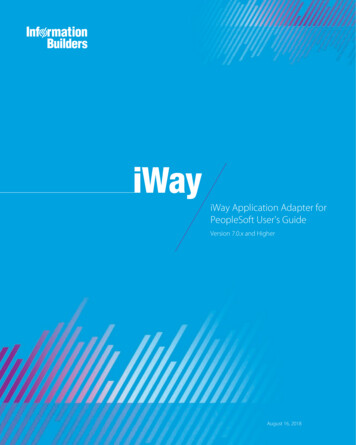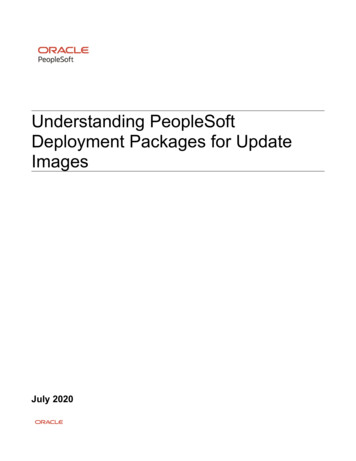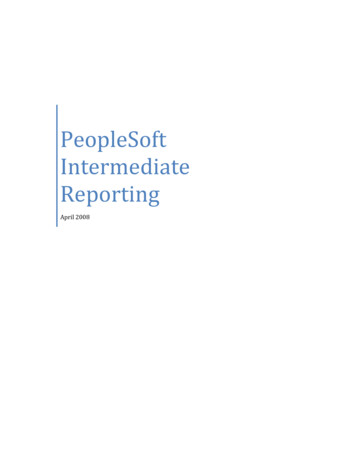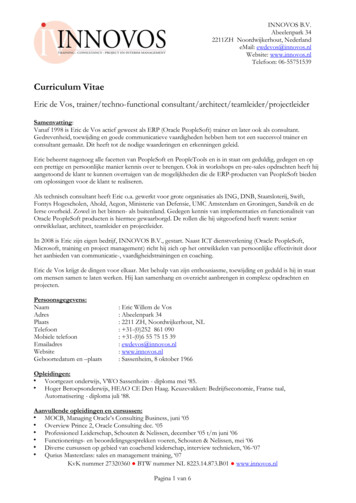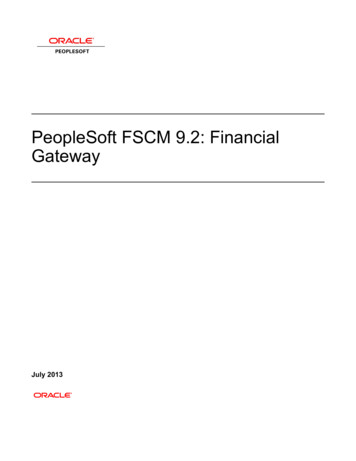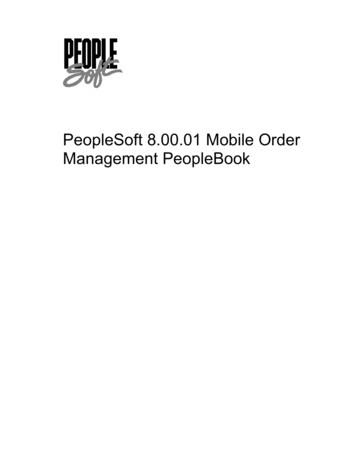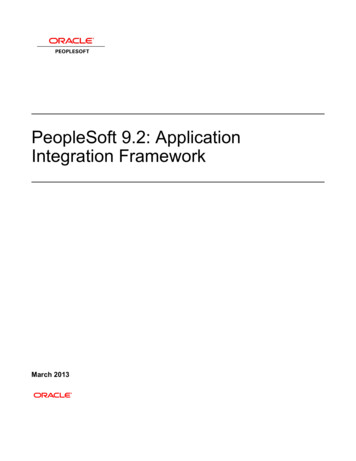
Transcription
PeopleSoft 9.2: ApplicationIntegration FrameworkMarch 2013
PeopleSoft 9.2: Application Integration FrameworkCDSKU elm92pbr0Copyright 1992-2013, Oracle and/or its affiliates. All rights reserved.Trademark NoticeOracle and Java are registered trademarks of Oracle and/or its affiliates. Other names may be trademarksof their respective owners.Intel and Intel Xeon are trademarks or registered trademarks of Intel Corporation. All SPARC trademarksare used under license and are trademarks or registered trademarks of SPARC International, Inc.AMD, Opteron, the AMD logo, and the AMD Opteron logo are trademarks or registered trademarks ofAdvanced Micro Devices. UNIX is a registered trademark of The Open Group.License Restrictions Warranty/Consequential Damages DisclaimerThis software and related documentation are provided under a license agreement containing restrictionson use and disclosure and are protected by intellectual property laws. Except as expressly permittedin your license agreement or allowed by law, you may not use, copy, reproduce, translate, broadcast,modify, license, transmit, distribute, exhibit, perform, publish, or display any part, in any form, or by anymeans. Reverse engineering, disassembly, or decompilation of this software, unless required by law forinteroperability, is prohibited.Warranty DisclaimerThe information contained herein is subject to change without notice and is not warranted to be error-free.If you find any errors, please report them to us in writing.Restricted Rights NoticeIf this is software or related documentation that is delivered to the U.S. Government or anyone licensing iton behalf of the U.S. Government, the following notice is applicable:U.S. GOVERNMENT END USERS: Oracle programs, including any operating system, integratedsoftware, any programs installed on the hardware, and/or documentation, delivered to U.S. Governmentend users are "commercial computer software" pursuant to the applicable Federal Acquisition Regulationand agency-specific supplemental regulations. As such, use, duplication, disclosure, modification,and adaptation of the programs, including any operating system, integrated software, any programsinstalled on the hardware, and/or documentation, shall be subject to license terms and license restrictionsapplicable to the programs. No other rights are granted to the U.S. Government.Hazardous Applications NoticeThis software or hardware is developed for general use in a variety of information managementapplications. It is not developed or intended for use in any inherently dangerous applications, includingapplications that may create a risk of personal injury. If you use this software or hardware in dangerousapplications, then you shall be responsible to take all appropriate fail-safe, backup, redundancy, andother measures to ensure its safe use. Oracle Corporation and its affiliates disclaim any liability for anydamages caused by use of this software or hardware in dangerous applications.
Third Party Content, Products, and Services DisclaimerThis software or hardware and documentation may provide access to or information on content, products,and services from third parties. Oracle Corporation and its affiliates are not responsible for and expresslydisclaim all warranties of any kind with respect to third-party content, products, and services. OracleCorporation and its affiliates will not be responsible for any loss, costs, or damages incurred due to youraccess to or use of third-party content, products, or services.Alpha and Beta Draft Documentation NoticeIf this document is in preproduction status:This documentation is in preproduction status and is intended for demonstration and preliminary use only.It may not be specific to the hardware on which you are using the software. Oracle Corporation and itsaffiliates are not responsible for and expressly disclaim all warranties of any kind with respect to thisdocumentation and will not be responsible for any loss, costs, or damages incurred due to the use of thisdocumentation.
ContentsContentsPreface.viiiUnderstanding the PeopleSoft Online Help and PeopleBooks. viiiPeopleSoft Hosted Documentation. viiiLocally Installed Help.viiiDownloadable PeopleBook PDF Files. viiiCommon Help Documentation. viiiField and Control Definitions. ixTypographical Conventions.ixISO Country and Currency Codes. xRegion and Industry Identifiers. xAccess to Oracle Support.xiDocumentation Accessibility.xiUsing and Managing the PeopleSoft Online Help. xiPeopleSoft Enterprise Components Related Links.xiContact Us.xiiFollow Us.xiiChapter 1: Getting Started with Application Integration Framework.14Understanding the Application Integration Framework. 14Application Integration Framework Implementation. 14Define Value Maps. 14Create Application Engine Transform Programs. 14Update Service Operation Routing. 15Chapter 2: Understanding Application Integration Framework.16Application Integration Framework.16Use Cases for Application Integration Framework. 17Maps. 18Domain Value Map. 19Cross-Reference Map. 19Functions to Populate and Maintain the Cross-Reference and DVMs.20Use Case: Integration Broker Transformation Without AIA Middleware. 21Use Case: Integration Broker Point-to-Point Transformation. 25Use Case: Integration Broker Transformation in Which a Third Party Uses AIA Middleware. 29Chapter 3: Defining and Populating Value Maps. 34Understanding Value Maps.34Defining Map Options. 37Page Used to Define Value Map Options.38Value Map Options Page.38Defining Value Maps. 40Pages Used to Define Value Maps. 40Define Value Maps search Page. 41Define Value Map - Elements Page.41Define options for a value map Page. 43Define Value Maps - Domains Page.44Populating a Domain Value Map. 46Page Used to Populate a Domain Value Map.46Domain Value Map Page. 46Importing Value Maps. 47ivCopyright 1992-2013, Oracle and/or its affiliates. All rights reserved.
ContentsPage Used to Import Value Map.47Understanding Import File Types Used with Value Maps.47Import Value Maps Page.49Exporting Value Maps. 51Understanding Export Schemas. 51Exporting a Value Map. 51Chapter 4: Creating Transform Programs and Updating Service Operations. 54Understanding Transform Programs. 54Creating a Transform Program. 55Updating Service Operation Routing. 56Chapter 5: Accessing Maps Using XSLT Extension. 58Understanding XSLT Extension Functions. 58Cross-Reference Functions. lementData. 59xref:populateXRefRow. 60xref:populateXrefRowNVP. f:lookupXRef. 67xref:lookupXRefNVP. 68Domain Value Map Functions. 69dvm:lookupValue. 69dvm:lookupValueNVP. 70dvm:lookup-dvm.71Generate-Guid Function.72generate-guid.73SetID Functions.73SetID:lookupSetCtrlValues. 73Chapter 6: Accessing Maps Using PeopleCode. 76Understanding Application Integration Framework Classes. 76How to Import Application Integration Framework Type Classes. 76DVM Utility Class Methods.77ExtractData.77LookupValue. 78LookupValue1M. 79LookupValueNVP. 80DVM Utility Class Properties. 81exceptionCaught.81exceptionDetails.81SetId Utility Class Methods.81lookupSetCtrlValues.81lookupSetID. 83Xref Utility Class Methods.84BulkPopulateDomainData. 84BulkPopulateElementData. 85ExtractData.86LookupValue. 87LookupValue1M. 88LookupValueNVP. 89MarkForDelete. 90Copyright 1992-2013, Oracle and/or its affiliates. All rights reserved.v
ContentsMarkForDeleteNVP. 91PopulateData. 92PopulateValue.94PopulateValueNVP.95Xref Class Properties. 96exceptionCaught.96exceptionDetails.96Chapter 7: Accessing Maps Using Web Services. 98Understanding Application Integration Framework Web Services. 98EOTF DVM Service. 99EOTF DVM LOOKUP. 99EOTF DVM IMPORT.v2.100EOTF DVM IMPORT.v1.101EOTF XREF Service.102EOTF XREF ADD.103EOTF XREF LINK.104EOTF XREF UPDATE. 105EOTF XREF DELETE. 106EOTF XREF LOOKUP. 107EOTF XREF IMPORT.v2.108EOTF XREF IMPORT.v1.110Cross-Reference Lookup Web Service Example.111Appendix A: Application Integration Framework Example.114Example Overview.114Defining a Dynamic Value Map.115Defining and Populating a Static Value Map. 116Using the XSLT Extension Function in the Transformation Program. 119Key Value Transformation. 119Domain Value Transformation. 120Updating the Service Operation Routing. 121viCopyright 1992-2013, Oracle and/or its affiliates. All rights reserved.
ContentsCopyright 1992-2013, Oracle and/or its affiliates. All rights reserved.vii
PrefacePrefaceUnderstanding the PeopleSoft Online Help and PeopleBooksThe PeopleSoft Online Help is a website that enables you to view all help content for PeopleSoftApplications and PeopleTools. The help provides standard navigation and full-text searching, as well ascontext-sensitive online help for PeopleSoft users.PeopleSoft Hosted DocumentationYou access the PeopleSoft Online Help on Oracle’s PeopleSoft Hosted Documentation website, whichenables you to access the full help website and context-sensitive help directly from an Oracle hostedserver. The hosted documentation is updated on a regular schedule, ensuring that you have access to themost current documentation. This reduces the need to view separate documentation posts for applicationmaintenance on My Oracle Support, because that documentation is now incorporated into the hostedwebsite content. The Hosted Documentation website is available in English only.Locally Installed HelpIf your organization has firewall restrictions that prevent you from using the Hosted Documentationwebsite, you can install the PeopleSoft Online Help locally. If you install the help locally, you have morecontrol over which documents users can access and you can include links to your organization’s customdocumentation on help pages.In addition, if you locally install the PeopleSoft Online Help, you can use any search engine for fulltext searching. Your installation documentation includes instructions about how to set up Oracle SecureEnterprise Search for full-text searching.See PeopleTools 8.53 Installation for your database platform, “Installing PeopleSoft Online Help.” If youdo not use Secure Enterprise Search, see the documentation for your chosen search engine.Note: Before users can access the search engine on a locally installed help website, you must enable theSearch portlet and link. Click the Help link on any page in the PeopleSoft Online Help for instructions.Downloadable PeopleBook PDF FilesYou can access downloadable PDF versions of the help content in the traditional PeopleBook format.The content in the PeopleBook PDFs is the same as the content in the PeopleSoft Online Help, but it hasa different structure and it does not include the interactive navigation features that are available in theonline help.Common Help DocumentationCommon help documentation contains information that applies to multiple applications. The two maintypes of common help are: viiiApplication FundamentalsCopyright 1992-2013, Oracle and/or its affiliates. All rights reserved.
Preface Using PeopleSoft ApplicationsMost product lines provide a set of application fundamentals help topics that discuss essential informationabout the setup and design of your system. This information applies to many or all applications in thePeopleSoft product line. Whether you are implementing a single application, some combination ofapplications within the product line, or the entire product line, you should be familiar with the contentsof the appropriate application fundamentals help. They provide the starting points for fundamentalimplementation tasks.In addition, the introduces you to the various elements of the PeopleSoft Pure Internet Architecture. Italso explains how to use the navigational hierarchy, components, and pages to perform basic functions asyou navigate through the system. While your application or implementation may differ, the topics in thisuser’s guide provide general information about using PeopleSoft Applications.Field and Control DefinitionsPeopleSoft documentation includes definitions for most fields and controls that appear on applicationpages. These definitions describe how to use a field or control, where populated values come from, theeffects of selecting certain values, and so on. If a field or control is not defined, then it either requiresno additional explanation or is documented in a common elements section earlier in the documentation.For example, the Date field rarely requires additional explanation and may not be defined in thedocumentation for some pages.Typographical ConventionsThe following table describes the typographical conventions that are used in the online help.Typographical ConventionDescriptionBoldHighlights PeopleCode function names, businessfunction names, event names, system function names,method names, language constructs, and PeopleCodereserved words that must be included literally in thefunction call.ItalicsHighlights field values, emphasis, and PeopleSoft orother book-length publication titles. In PeopleCodesyntax, italic items are placeholders for arguments thatyour program must supply.Italics also highlight references to words or letters, as inthe following example: Enter the letter O.Key KeyIndicates a key combination action. For example, a plussign ( ) between keys means that you must hold downthe first key while you press the second key. For Alt W,hold down the Alt key while you press the W key.Monospace fontHighlights a PeopleCode program or other codeexample.Copyright 1992-2013, Oracle and/or its affiliates. All rights reserved.ix
PrefaceTypographical ConventionDescription. . . (ellipses)Indicate that the preceding item or series can be repeatedany number of times in PeopleCode syntax.{ } (curly braces)Indicate a choice between two options in PeopleCodesyntax. Options are separated by a pipe ( ).[ ] (square brackets)Indicate optional items in PeopleCode syntax.& (ampersand)When placed before a parameter in PeopleCode syntax,an ampersand indicates that the parameter is an alreadyinstantiated object.Ampersands also precede all PeopleCode variables. This continuation character has been inserted at theend of a line of code that has been wrapped at the pagemargin. The code should be viewed or entered as asingle, continuous line of code without the continuationcharacter.ISO Country and Currency CodesPeopleSoft Online Help topics use International Organization for Standardization (ISO) country andcurrency codes to identify country-specific information and monetary amounts.ISO country codes may appear as country identifiers, and ISO currency codes may appear as currencyidentifiers in your PeopleSoft documentation. Reference to an ISO country code in your documentationdoes not imply that your application includes every ISO country code. The following example is acountry-specific heading: "(FRA) Hiring an Employee."The PeopleSoft Currency Code table (CURRENCY CD TBL) contains sample currency code data. TheCurrency Code table is based on ISO Standard 4217, "Codes for the representation of currencies," andalso relies on ISO country codes in the Country table (COUNTRY TBL). The navigation to the pageswhere you maintain currency code and country information depends on which PeopleSoft applicationsyou are using. To access the pages for maintaining the Currency Code and Country tables, consult theonline help for your applications for more information.Region and Industry IdentifiersInformation that applies only to a specific region or industry is preceded by a standard identifier inparentheses. This identifier typically appears at the beginning of a section heading, but it may also appearat the beginning of a note or other text.Example of a region-specific heading: "(Latin America) Setting Up Depreciation"Region IdentifiersRegions are identified by the region name. The following region identifiers may appear in the PeopleSoftOnline Help: xAsia PacificCopyright 1992-2013, Oracle and/or its affiliates. All rights reserved.
Preface Europe Latin America North AmericaIndustry IdentifiersIndustries are identified by the industry name or by an abbreviation for that industry. The followingindustry identifiers may appear in the PeopleSoft Online Help: USF (U.S. Federal) E&G (Education and Government)Access to Oracle SupportOracle customers have access to electronic support through My Oracle Support. For information, visithttp://www.oracle.com/pls/topic/lookup?ctx acc&id info or visit http://www.oracle.com/pls/topic/lookup?ctx acc&id trs if you are hearing impaired.Documentation AccessibilityFor information about Oracle's commitment to accessibility, visit the Oracle Accessibility Programwebsite at http://www.oracle.com/pls/topic/lookup?ctx acc&id docacc.Using and Managing the PeopleSoft Online HelpClick the Hel
Understanding the PeopleSoft Online Help and PeopleBooks The PeopleSoft Online Help is a website that enables you to view all help content for PeopleSoft Applications and PeopleTools. The help provides standard navigation and full-text searching, as well as context-sensitive online help for PeopleSoft users. PeopleSoft Hosted Documentation
